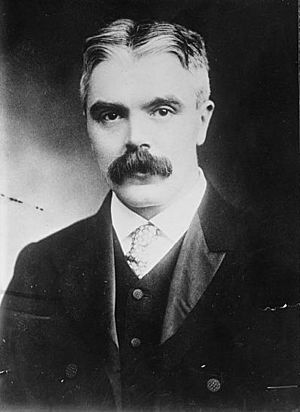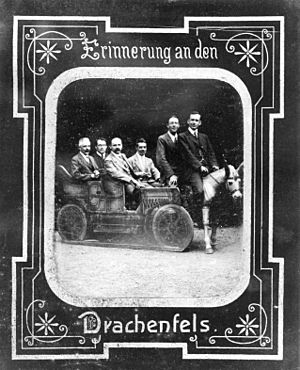Frank Watson Dyson facts for kids
Quick facts for kids
Sir Frank Watson Dyson
|
|
|---|---|
 |
|
| Born | 8 January 1868 Measham, Leicestershire, England
|
| Died | 25 May 1939 (aged 71) At sea
|
| Alma mater | Trinity College, Cambridge |
| Known for | Astronomer Royal |
| Awards | Royal Medal (1921) |
| Signature | |
Sir Frank Watson Dyson was an important English astronomer. He was born on January 8, 1868, and passed away on May 25, 1939. He is best known for two big achievements.
First, he started the famous "pips" – the short beeping sounds that tell the exact time. These signals came from Greenwich, England. Second, he played a key role in proving Albert Einstein's amazing theory of general relativity. This theory changed how we understand gravity.
Contents
Life and Work
Frank Dyson was born in a small town called Measham in England. His father was a Baptist minister. As a young boy, Frank moved to Yorkshire. He went to Heath Grammar School and then Bradford Grammar School.
He was very smart and won scholarships to Trinity College, Cambridge. There, he studied mathematics and astronomy. He finished his studies in 1889.
Early Career in Astronomy
In 1894, Frank Dyson joined the Royal Astronomical Society. He also became part of the British Astronomical Association. He got a job as a Senior Assistant at the Royal Greenwich Observatory.
At Greenwich, he worked on a huge project called the Astrographic Catalogue. This was a detailed map of the stars. It was published in 1905.

Becoming Astronomer Royal
From 1905 to 1910, Dyson was the Astronomer Royal for Scotland. This was a very important position. Then, in 1910, he became the Astronomer Royal for England. This also made him the Director of the Royal Greenwich Observatory. He held this role until 1933.
Introducing Time Signals
Sir Frank Dyson made timekeeping much more accurate. In 1928, he brought a new type of clock to the Observatory. It was called a free-pendulum clock and was the most precise clock of its time.
He then arranged for the exact time to be sent out by radio. This was done from the GPO wireless station in Rugby. In 1924, he also started the "six pips" that you hear on the BBC. These short beeps help everyone know the exact time.
He was also the President of the British Horological Institute for many years. This group studies and promotes timekeeping. He received their gold medal in 1928.
Studying Solar Eclipses
Sir Frank Dyson was very interested in solar eclipses. These are times when the Moon passes in front of the Sun. He was an expert on the light from the Sun's outer atmosphere, called the solar corona.
He is famous for organizing trips to observe the 1919 solar eclipse. These expeditions went to Brazil and Príncipe. He started planning these trips even before World War I ended.
Proving Einstein's Theory
On November 6, 1919, Dyson shared his observations from the 1919 eclipse. He presented them at a special meeting of the Royal Society. The observations showed that light from distant stars bent as it passed near the Sun.
This bending of light was exactly what Albert Einstein's theory of gravity had predicted. Before this, many scientists were unsure about Einstein's ideas. Dyson's work helped prove that Einstein was right. This was a huge moment in science.
Sir Frank Dyson died in 1939 while traveling by ship from Australia to England. He was buried at sea.
Awards and Recognitions
Sir Frank Dyson received many honors for his important work.
- Fellow of the Royal Society – 1901
- Fellow of the Royal Society of Edinburgh – 1906
- President, Royal Astronomical Society – 1911–1913
- Vice-president, Royal Society – 1913–1915
- Knighted – 1915
- President, British Astronomical Association, 1916–1918
- Royal Medal of the Royal Society – 1921
- Bruce Medal of the Astronomical Society of the Pacific – 1922
- Gold Medal of the Royal Astronomical Society – 1925
- Knight Commander of the Order of the British Empire – 1926
- Gold medal of British Horological Institute – 1928
- President of the International Astronomical Union – 1928–1932

Two space objects are named after him:
Family Life
In 1894, Frank Dyson married Caroline Bisset Best. They had a large family with two sons and six daughters. Caroline passed away in 1937.
Connection to Freeman Dyson
You might have heard of another famous scientist named Freeman Dyson. He was a theoretical physicist. Even though Frank and Freeman Dyson shared the same last name, they were not known to be related. However, both their fathers came from the same area in England.
Freeman Dyson said that Sir Frank sparked his interest in astronomy. Because they had the same last name, Freeman's family often talked about Sir Frank's achievements when Freeman was a boy. This inspired Freeman to write his first story about space when he was young.
In Popular Culture
The actor Alec McCowen played Sir Frank Dyson in the TV series Longitude in 2000. This series was about the history of finding longitude at sea.
Selected Writings
- Astronomy, Frank Dyson, London, Dent, 1910
Images for kids
See also
 In Spanish: Frank Watson Dyson para niños
In Spanish: Frank Watson Dyson para niños
- Einstein and Eddington


